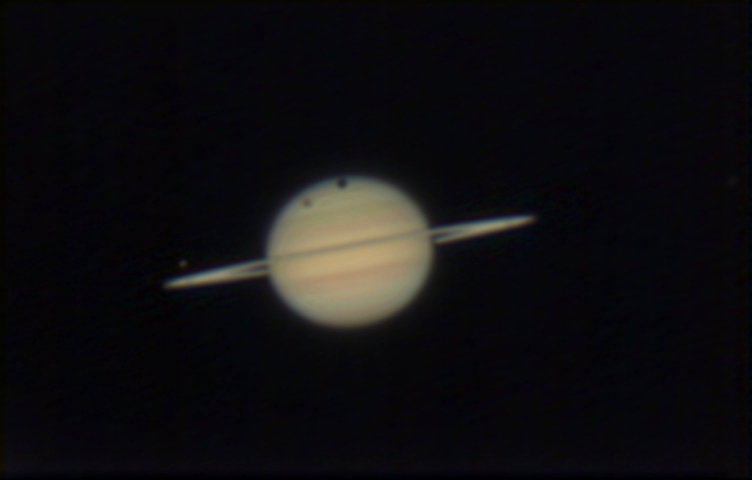
We rarely see Saturn's moons cast shadows on the planet's disk. However, roughly every 15 years or so we see Saturn's rings turned edgewise relative to our viewpoint. At these times, it is possible for Saturn's moons to transit the planet, and for us to see a moon's shadow likewise transit Saturn. Normally, the only planet that regularly provides us with shadow transits of its moons is the great planet Jupiter.
This image shows the moon Titan transiting Saturn (the dark spot on the left), preceded by Titan's shadow transiting at the top of Saturn's disk near the pole. Titan orbits at a substantial distance from Saturn, so it took a relatively long time to transit the planet's disk. It was much longer, as compared to the fast-moving shadow transits that the moon Io makes across Jupiter. Titan was still transiting when Saturn set in the west. After Saturn set, and was no longer observable from my location, the moon on the left just above Saturn's rings also transited the planet while Titan was still slowing making its way across Saturn's disk.
This image was obtained by taking the best 500 frames of video captured by a webcam using the 24-inch RCOS telescope at the University of Arizona SkyCenter on Mount Lemmon. Adam Block is conducting nightly observing programs at the University of Arizona SkyCenter that are open to the public. You can view and understand the night sky with an expert astronomer to guide you on an adventure under the stars, and the 24-inch RCOS telescope that I used to take this image is dedicated to that public outreach program. This image was published in the photo gallery on the Anacortes Telescope & Wild Bird website.
Constellation: Leo
RA: 11h 24m 23s Dec: +06d 17' 06"
February 24, 2009
Image by Sid Leach, Adam Block, and Francisco
Arabia
Mount Lemmon, Arizona
Recent Images.
Complete list of images.
Description of equipment used to acquire images.
Home
Feedback and comments should go to Sid